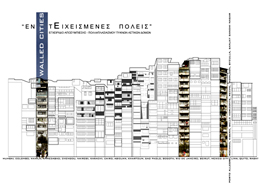STUDENTS PROJECTS
PROJECTS 2011

06 June, 2012
Walled Cities
Manual of decompression and multiplication of dense urban structures.
Student : Orfanou Aleksandra - Xristina
Supervisor: Gvrilou Evelin
University of Thessaly_ Department of Architecture Engineering
Date of Presentation: 02/03/2011
This study treats spatial ideas both literally and symbolically. These ideas are listed and organized in order to form a manual of potential improvements on dense city fronts. Four of the infinite combinations of the manual - elements are chosen at random to be presented in this study. Each combination leads to an architectural plan, proposed to upgrade the complex civil scenery of the contemporary slums.
In my Thesis Project I have continued working on the concept that was posed and developed in my research work, entitled "Wells as spatial metaphors of the self (ego) in literature". This project referred to, commented on, and correlated literature texts involving a particular kind of space : frear (the well in ancient greek) and then was attempted a parallelism of this space with the ego and the most basic part of it, the memory.
On this project the concept of the "frear" was used as an analog of the vertical interstitial empty spaces between high-rise buildings in big modern cities, a kind of "urban well", an empty space that disrupts the continuity of the front of the city. The spatial qualities of the well form large lists of literal and metaphorical ideas, organized in an array, which has horizontal and vertical columns. The horizontal categories are four: 1. Well, 2. Ego, 3. Buildings and 4. City. These lists constituted the horizontal parts of an array, and the factors, about which these spaces were studied, were organized as the vertical parts of the array. These five vertical categories were: nets-infrastructural systems, solid vs void, city fronts-frontiers, social status, and improvement strategies.

In order to use the contrast of the empty well with the solid ground (it's very obvious on the cross section) as a tool in rereading the cities, I 've chosen to work with cities of the highest density globally, such as favellas in Rio de Janeiro and Mexico, Kowloon in Hong Kong and other slums. My study focused on the successive elevations of the buildings of slums, walls, city-fronts, external borderlines. Moreover, the inner conditions of these cities are similar of those of a well, mostly because of the lack of adequate space, light and air.

Many diagrams and models were made to represent these contrasting relations. At the elevations, walls and fronts of those cities, I was especially interested in the contrasting spatial relations that develop, such as of light and shadow, or empty and full, or niche and extrusion. Then diagrams and models were made to represent these relations. The diagram that follows organizes the cross sections of memory neurons, wells, underground networks, buildings, cities, and the ground, having as a background setting the city, which plays a supporting role working as a trace-ruler.

Except for the diagram, some models of wax were also constructed. These three-dimensional objects contributed to the expression and the perception of the spatial relations. The wax was chosen as a material because it can "carry-remember" the work that is done on its mass. Every touch on its surface leaves a trace and its actual form results from a mold, which has exactly the opposite geometry of the object itself. This fact is perfectly placed among the contrasting relations studied.

The proposed plans were conceived based on the diagrams, the models and the lists of ideas, which were the main conceptual design tools. The array of the lists acts as a field condition of multiple possible paths, which give different results according to the way of combining the parts. An example could be Α VI 3-5 - B III 1-3 - Δ ΙΙΙ 4 - Ε VI 1, a random choice in a net of nodes, links routes, free and coincidental or result of thinking and planning, they lead to proposals in order to improve the living conditions in the slums. If we see this whole project more freely, these routes could refer to any city under different circumstances.


This "system" is nothing but a proposal to the difficult problem of the slums, but it does not claim to be capable of dealing with this particular urban matter as a whole. On the contrary, it provides spotted, small scale interventions, which occur to "weak" spots, places where people suffer more, where small "breaths" are necessary and relieving. The main intention of those small scale proposals is to channel the air and light into the "Walled Cities", without breaking the city front.
Despite that fact, a very detailed design of a slum has been attempted. This project has taken into consideration the structuring principles of those societies, in order to humanize the living conditions of the residents without taking away their sense of comfort. Planting in balconies and rooftops, communal kitchens, toilets/restrooms, and washing machines, public spaces, small and ergonomic designed apartments, sewers and other infrastructural systems, are just some of the suggestions of the new building complex.



His approach is clearly conceptual, as the design of such a complex building would be impossible to be accomplished by just one person. Moreover, the array as a conceptual design tool -despite being rational, it cannot include every possible correlation between the ideas. The system that could be able to express the complexity of these relations would be expected to seem as a chaotic mesh of diagrammatical geometry.











